#cuban bongos
Text
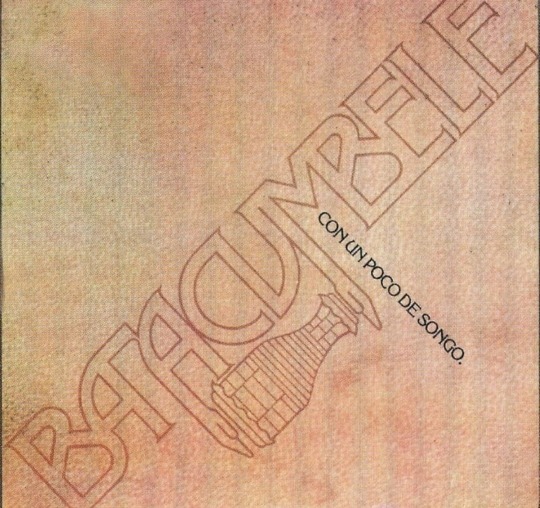
Batacumbele [meaning "to kneel before the drum" in Yoruba] was founded in 1980 in San Juan, Puerto Rico by master percussionist Angel "Cachete' Maldonado and is one of the leading Afro-Caribbean ensembles in the world. It is to contemporary Puerto Rican music what Irakere is to Cuba.
When Angel wanted to become more serious about native Puerto Rican drumming, he sought out Julio 'Caesar' Maco Rivera. There were the traditional congas, bongos, timbales, and other hand drums, but he was also introduced to the bata drums and their Yoruban sacred ceremonial rituals of Orisha. At the time the bata drum was rarely played in Puerto Rico, this being a strong Cuban influence that would permeate later thanks to Angel's introduction of these drums to a greater audience.
Angel was soon good enough to join up with Johnny El Bravo, who fronted one of the most popular dance groups on the island. By 1970, salsa was very popular. This introduced Angel to other musicians, such as Julito Collazo and Carlos 'Patato' Valdes, the Cuban drum masters who brought awareness of the bata drums to New York, where Angel relocated in the early 70s to join the salsa explosion there.
Angel also played for salsa bands La Conspiracion, Conjunto Libre, and Tipica 73, and for salsa pianist Larry Harlow. He played with Gato Barbieri for four years after being asked to join his band. He even did some gigs with Dizzy Gillespie.
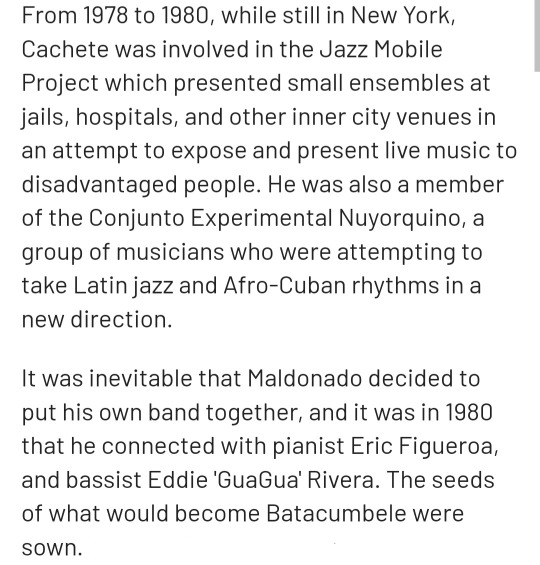



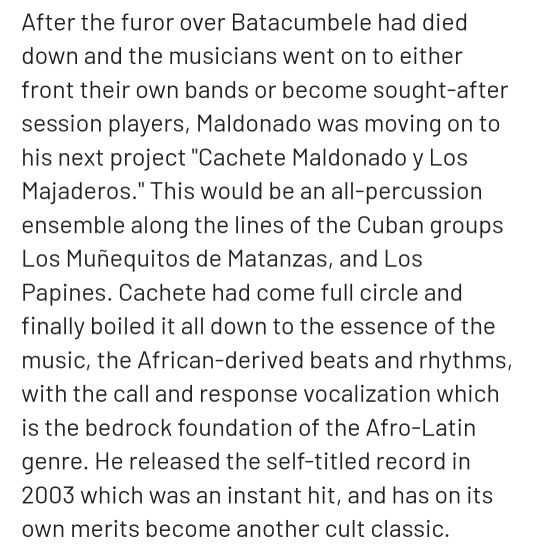
7 notes
·
View notes
Text
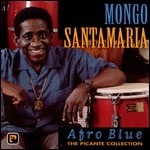
Ramón “Mongo” Santamaría Rodríguez (April 7, 1917 – February 1, 2003) was a Cuban percussionist and bandleader who spent most of his career in the US. Primarily a conga drummer, he was a leading figure in the pachanga and boogaloo dance crazes of the 1960s. His biggest hit was his rendition of Herbie Hancock’s “Watermelon Man”, which was inducted into the Grammy Hall of Fame in 1998. From the 1970s, he recorded mainly salsa and Latin jazz, before retiring in the late 1990s.
He learned to play the congas as an amateur rumba musician in the streets of Havana. He then learned the bongos from Clemente “Chicho” Piquero and toured with various successful bands such as the Lecuona Cuban Boys and Sonora Matancera. In 1950, he moved to New York City, where he became Tito Puente’s conguero, and in 1957 he joined Cal Tjader’s band. He formed his charanga, while at the same time recording some of the first rumba and Santería music albums. By the end of the decade, he had his first pachanga hit, “Para ti”. He became a pioneer of boogaloo with “Watermelon Man” and later signed record deals with Columbia, Atlantic, and Fania. He collaborated with salsa artists and became a member of the Fania All-Stars, often showcasing his conga solos against Ray Barretto. In his later years, he recorded mostly Latin jazz for Concord Jazz and Chesky Records.
He was inducted into the International Latin Music Hall of Fame and the Billboard Latin Music Hall of Fame the following year. #africanhistory365 #africanexcellence
2 notes
·
View notes
Text
So there's a post going around about how Hobbie Brown (Spider-punk) would listen to Taylor Swift. And actual punks going "No the fuck he wouldn't".
And they are right. He would fucking not. Instead I would like to give my humble offer of what kind of artist Hobbie would listen other than punk:
The Orishas

Wikipedia: Orishas are a Cuban hip hop group from Havana, Cuba, founded in 1999. The group was first called "Amenaza",[1] "threat" or "menace" in Spanish, and appealed to the Cuban youth. The choice of this name for the hip hop group is a way of creating a direct link between this band and the African diaspora.
They have covered a vairety of topics like migration, racism, identity, feminism and Afro-cuban religion.
Their sound is an artfull combination between hip-hop and latin carribean rythms.
They have several discs out but their most popular (and the first one I listen to is) "A lo cubano" it stars with a nice acoustic instrumental carribean percussion bongo and then dives into the 2nd song:
Represent.
I like to headcanon that it was Miles or the daredevil in his universe (forgot her name) that introduce him to the group. And if it was Miles, that it was her mother in turn that introduce the band to the spider man. (Kinda how it was with me).
And obviously he would listen to SKA. (Unfortunately idk any Jamaican ska groups which is such a slight for me since the genre comes from there, aaah, pls give me recs.)
#hobbie brown#spider punk#spider punk comics#accross the spiderverse#ha you fell for my trap this is just part of my agenda to promote latin music & artists#Spotify#music#taylot swift#ska#orishas
5 notes
·
View notes
Video
youtube
https://www.youtube.com/watch?v=oY6ADogjsLA
The Jewish Latin dance craze of the 50s wasn’t just Jewish bands playing Cuban music. It was also Jewish bands playing Jewish melodies Cuban style! The Miami Merengue has the hot beat you want for your night out with your spouse in 1959, but listen closely . . . the melody is an old Yiddish folk tune, “Der Rebbe Elimelech!” The whole album (Bagels and Bongos) is like this -- other tracks include the Hava Nagila paso doble, the Bei Mir Bistu Sheyn mambo, or the I Love You Much Too Much rhumba. In fact, this album did so well that Irving Fine went on to do a few sequels. Perhaps we’ll hear more of them later . . .
3 notes
·
View notes
Photo

The Aquarium Drunkard Show: SIRIUS/XMU (7pm PDT, Channel 35)
No static at all. Via satellite, transmitting from northeast Los Angeles — the Aquarium Drunkard Show on SIRIUS/XMU, channel 35. 7pm California time, Wednesdays.
Intro ++ Red Garrison – Taboo ++ The Moroccos – Morocco Chant ++ Ted Heath – Shish Kebab ++ Cozy Cole – Blop Up & Blop Down ++ Perez And Brana – The Crazy Cuban ++ Cool Wise Men – Lizard ++ Gus Jenkins – Tricky Too ++ John Lee Hooker – Baby Lee ++ Little Stevie Wonder – Soul Bongo ++ Danny Cobb – My Isabella ++ Dave Cortez – Piano Shuffle ++ Renaldo Jackson – Congolese Tip ++ Mike Sanchez – Crawfish ++ Os Bongos – Pachanga Maria ++ The Fabulous Preston Combo – Ooh-La-Cha-Cha ++ The Terrifics – Loco ++ The Calvaes – Lonely Lonely Village ++ Diane Maxwell – Love Charms ++ Danny Le Cina – Triste ++ Gerald Wilson – Mambo Mexicano – Part 1 ++ Ike Turner & His Kings of Rhythm – Katanga ++ The King’s Henchmen – Gosan ++ Coleman Hawkins – Montono Blues ++ Alexis Korner’s Blues Incorporated – Early In The Morning ++ Them – One Two Brown Eyes ++ The Platters – I Just Want To Mambo ++ Lee Perry & the Soulettes – Rub & Squeeze ++ Baba Brooks & His Band – This Is Thunder ++ Os Kiezos – Comboio ++ Plearn Promdan – Wan Maha Sanook ++ The Blonde Bomber – I Am To Blame ++ Tom & Dito – Amanhanga ++ Group Lewlewal – Ligeey ++ Les Griots (with Serge Franklin) – Liwa Wetche ++ Norma Tanega – You’re Dead ++ Wayne Jackson – It Happened in Tennessee ++ Dave Diddley Day – Blue Moon Baby ++ Rex Garvin & The Mighty Cravers – Emulsified ++ Cat – Watussi ++ Screaming Lord Sutch – Flashing Lights ++ Bob Azzam & His Orchestra – The Last Time ++ Robb London – Gloria ++ John D. Loudermilk – Goin’ To Hell On A Sled
4 notes
·
View notes
Photo

Epistrophy Arts presents
Meridian Brothers (Bogotá, Col)
With Superfónicos (ATX)
Tuesday August 16. 8pm
Antone's Nightclub (305 E 5th St., Austin, TX 78701)
Tickets $25 advance, $35 door
“Genius prophets of colombian weirdness" - MTV Iggy
“For those who haven’t heard previously heard them, Colombia’s Meridian Brothers are easily among the most interesting groups in South America” - AFROPOP
“Tuneful, clever and enormous fun” - THE GUARDIAN
“The Meridian brothers push all boundaries of what you think you know about music. Promise, you'll love it” - NPR
“So why listen? Because it takes a strong will and clear musical vision for a band to cut through all the music for which Colombia is known” - NPR
“A dream world between electronic experimentation and regional folk” - LE MONDE
“Tropical madness from the most consistent of all the “world for club culture” labels. Twisted cumbia at around 150BPM... terrorises the dancefloor!”- GILLES PETERSON
Colombian guitarist and composer Eblis Alvarez started Meridian Brothers back in 1998 as a vehicle for his own experimental music. Over the years, the group has evolved into a five-piece band focused on re-interpreting all manners of Latin Tropical styles with a strong psychedelic and experimental sensibility. The Meridian Brothers’ music uses popular Latin American rhythms, augmented by sampling techniques, elaborate effect processing, and Eblis’ quirky and theatrical vocals, which channel imaginary characters with both pathos and humor.
The group has released records on Soundway records, Names You can Trust and Bongo Joe and have proved very popular in South America and Europe where the band has toured extensively and has started to reach out to an audience more familiar with indie rock and experimental than Latin music.
Meridian's new album is a tribute to New York's 70's era Salsa Dura. For the project, they have created an avatar, a fictitious group named El Grupo Renacimiento, and written a new repertoire trying to emulate the writing style of those late 60's and early 70's groups while retaining the Meridian Brothers idiosyncratic style of arranging and recording. The sound of instruments has been modified to fit the Meridian electronic templates, and the result is a fantastic album true to the spirit of Salsa Dura and in line with Eblis Alvarez two decade-long experiment with Latin tropical sounds.
The album will be released on the Ansonia label - a historical Latin label that was specialized in Puerto Rican, Dominican and Cuban music from the 1960's and has only recently been revived and has made its catalog finally available on digital platforms.
Meridian Brothers new album will be their first release in over 30 years - a nod from Ansonia Records to the legacy of Latin music history as it steps into the modern era.
Eblis Alvarez has been an intricate part of the new generation of Colombian musicians for the past ten years. He is also a former member of Frente Cumbiero and a current member of trio Los Pirañas.
Meridian Brothers include Maria Valencia (saxophone, clarinet, percussion and synthesizers), , Cesar Quevedo (bass) and Alejandro Forero (electronics and synthesizers) Mauricio Ramirez (drums)
Superfónicos is Colombian Funk. Better yet, it is Caríbe Soul…fed by the Indigenous and African roots of the band’s Colombian heritage, telegraphing a politics of peace and unity from the stage to your ears. They only ask that you dance toward a place in your mind beyond struggle and strife.
Superfónicos was formed when bassist Nico Sanchez and guitarist Erick Bohorquez began discussions about creating a group with a foundation in Afro-Colombian rhythms. They soon teamed up with guitarist Andres Villegas and percussionist Daniel Sanchez, and started rehearsing together during time away from their other bands. That core group developed the band’s unique sound, laying the foundation of what was to come. In 2016, gaitero and vocalist Jaime Ospina—who has recorded with the likes of Pacha Massive—relocated from Colombia to Austin, where he met and instantly connected with the group. It was also during this time that the band met with famed local producer and Grammy winner Adrian Quesada at Level One Sound. Their recording session resulted in a sound that not only encapsulates a moment in time but helped to define Superfónicos as a collective. It is a musical mestizo that is ever-changing but deeply rooted in Caribbean flavors.
Epistrophy Arts is a grass-roots cultural organization dedicated to presenting the finest adventurous and improvised music in Austin Texas. Since January of 1998 we have presented over 50 concerts with some of the major figures in international contemporary adventurous music
This project is supported in part by the Cultural Arts Division of the City of Austin Economic Development Department.
2 notes
·
View notes
Photo
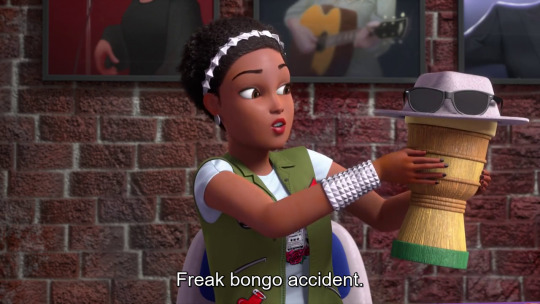
Bongos are an Afro-Cuban percussion instrument consisting of a pair of small open bottomed hand drums of different sizes.
4 notes
·
View notes
Text
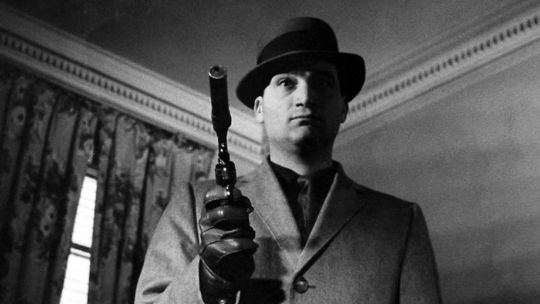
Allen Baron in Blast of Silence (Allen Baron, 1961)
Cast: Allen Baron, Mollie McCarthy, Larry Tucker, Peter Clune, Danny Meehan, Howard Mann, Lionel Stander (voice). Screenplay: Allen Baron, Waldo Salt (voiceover narration). Cinematography: Merrill S. Brody. Art direction: Charles Rosen. Film editing: Merrill S. Brody, Peggy Lawson. Music: Meyer Kupferman.
A very late film noir, Blast of Silence strips the genre to its bleak essence. A hitman (Allen Baron) comes to New York at Christmastime to whack a guy, falls in love, carries out his job, and pays the consequences for his decision that this would be his last hit. Made on a shoestring with equipment that had been smuggled out of Cuba after Baron appeared in Errol Flynn's last movie, Cuban Rebel Girls (Barry Mahon, 1959), it's a tightly assembled sleeper of a movie that wonderfully milks its New York location and ends with a memorable scene shot on Long Island during Hurricane Donna. Baron had wanted his friend Peter Falk to play the melancholy gunman, but took over the role himself when Falk was unavailable. It's a great one-off of a performance: Baron has no other acting credits besides this one and the Flynn movie, and his directing credits were mostly in TV on shows ranging from Surfside 6 to The Love Boat. The atmosphere of New York in the late 1950s and early '60s is wonderfully captured: That beatnik-era accoutrement the bongo drum makes its appearance at a party and again as the accompaniment to some mopey ballads with titles like "Dressed in Black" and "Torrid Town," sung by Dean Sheldon at the Village Gate nightclub. A voiceover narrative, written by Waldo Salt under his nom de blacklist "Mel Davenport" and read by uncredited fellow blacklistee Lionel Stander, was added after the film was assembled to cover some expository gaps. It's more effective than most voiceovers are at setting the mood and tone of the film, although I find it occasionally too portentous.
1 note
·
View note
Text
Jess Watches // Thu 2 Nov // Day 44
Synopses & Favourite Scenes
Call the Midwife (with mum)
6x06 Episode 6
As the Cuban Missile Crisis brings fear to Poplar, Sister Julienne tries to arrange the return of Sister Mary Cynthia, while Valerie deals with a very challenging case.
Dr. Turner sharing with Cynthia his own past troubles with mental health to show her she isn't alone and there is hope. Also Phyllis, yet again, being the comfort and encouragement to the midwives in their hour of need.
Class of '07
1x05 The People vs. Saskia
Genevieve brings Saskia to trial for her mean girl crimes, while Zoe finds herself in a tight spot when Amelia agrees to defend Saskia.
Saskia not only admitting to everything bad she has done, but also breaking down and revealing the reason behind it all. She was just a child ffs. I hope she can actually begin to heal now and make amends with the girls. Caitlin Stasey acted it brilliantly, these past 2 eps especially.
Curses!
1x03 The Baboon Temple
The Vanderhouvens leave home to search for answers about a cursed artifact from the Congo. But upon arrival, they face unexpected mayhem.
Um bongo! Um bongo! They drink it in the Congo! <Not at all relevant to the episode but it just popped into my head rereading the ep description. Anyhoo, the silhouettes of the baboons, with their glowing red eyes, against a purple background was very effective. I love the spooky colour palette.
Sex Education
4x02 Episode 2
When a couple is on the rocks, Otis eyes an opportunity. Surprises in the bedroom leaves Jackson questioning his sexuality.
Aimee bonding with Isaac over her childhood pet melon was very sweet. She is indeed weird in a lovely way. And I thought it was well written and realistic to highlight the possible negative after effects of coming out to your family as shown through Eric and Abbi's storylines. Also, has no one learned British Sign Language? For such a progressive school you'd think they'd be more aware of their ableism.
1 note
·
View note
Text
Stamps of Cuba: A Philatelic Journey Through History and Culture
In the colorful world of philately, stamps serve as miniature canvases that capture the essence of a nation's history, culture, and aspirations. Cuba, the vibrant island nation in the Caribbean, is no exception. The stamps of Cuba stand as intricate storytellers, weaving narratives of revolution, art, flora, fauna, and national pride. Each stamp is a testament to the country's rich heritage and the creative spirit of its people, inviting collectors and enthusiasts on a captivating philatelic journey.
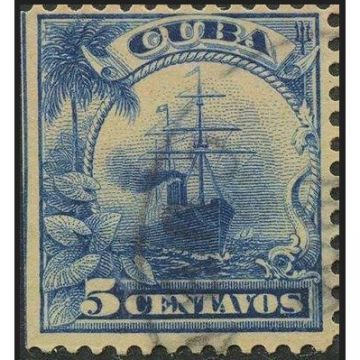
Revolutionary Themes: A Symbol of Freedom
One of the prominent themes found in Cuban stamps revolves around the nation's revolutionary history. Images of Che Guevara, Fidel Castro, and other revolutionary leaders often grace these tiny pieces of art. These stamps serve as a homage to the indomitable spirit of the Cuban people, commemorating the struggle for independence and freedom that has defined the nation's identity.
Cultural Heritage and Artistic Expression
Cuban stamps also celebrate the nation's rich cultural heritage. They feature iconic symbols like the classic American cars that roam the streets of Havana, traditional musical instruments like bongos and maracas, and vibrant renditions of Afro-Cuban dance forms. Additionally, Cuban stamps often showcase the works of renowned artists, offering a glimpse into the country's artistic prowess.
Flora, Fauna, and Natural Wonders
The diverse and unique biodiversity of Cuba finds its way onto stamps, showcasing the island's remarkable flora and fauna. Colorful birds like the Cuban Trogon and the Bee Hummingbird, the world's smallest bird, often grace these stamps. Picturesque landscapes, including pristine beaches, lush forests, and scenic mountains, are beautifully depicted, serving as a tribute to Cuba's natural wonders.
Historical Milestones and Commemorative Events
Cuban stamps also commemorate significant historical milestones and events. From anniversaries of revolutionary victories to international collaborations and cultural festivals, these stamps capture moments that have shaped the nation's trajectory. Each stamp becomes a time capsule, preserving the essence of these events for future generations.
Philately as Cultural Preservation
Beyond their aesthetic appeal, stamps of Cuba play a vital role in cultural preservation. They immortalize traditions, historical figures, and national achievements, ensuring that these aspects of Cuban heritage are not forgotten. Philatelists, historians, and enthusiasts pore over these stamps, decoding the stories they tell and preserving the nation's legacy for posterity.
Connecting Collectors Across Borders
Cuban stamps have a global appeal, drawing collectors and enthusiasts from various corners of the world. Through international philatelic exchanges, these stamps travel far and wide, connecting people, cultures, and histories. The fascination for Cuban stamps transcends geographical boundaries, fostering a sense of camaraderie among collectors who share a passion for these exquisite artifacts.
In the intricate designs and vivid colors of Cuban stamps, there lies a world of history, culture, and art. Each stamp is a testament to Cuba's enduring spirit, encapsulating the nation's journey through time. For philatelists and enthusiasts, these stamps are not just collectibles; they are windows into the heart and soul of a nation, inviting the world to explore the enchanting tapestry of Cuba's past, present, and future.
0 notes
Text
A Short History of the Bongos
A Short History of the Bongos
https://www.denverpercussion.com/a-short-history-of-the-bongos/
The bongos, those iconic drums that bring a lively Latin flavor to music, have a very interesting history. Originally hailing from Cuba, they made their way into the hearts and hands of musicians worldwide.
These lively instruments trace their roots back to the Afro-Cuban percussion traditions of the late 19th century. Derived from the larger Afro-Cuban drums, the bongos were initially created as a portable and versatile alternative. The instrument consists of two small, single-headed drums connected by a wooden or metal bridge.
In the early 20th century, bongos gained popularity in Cuban dance bands. As Cuban music began to spread to other parts of the world, so did the bongos. They found their way into jazz, particularly during the Latin jazz explosion of the 1940s and '50s, thanks to musicians like Chano Pozo and Desi Arnaz. The distinctive sound of the bongos added a vibrant and percussive element to jazz compositions.
The bongos continued to evolve and found their place in various musical genres, including salsa, mambo, and even rock and pop. They became a staple in Latin music, and their rhythmic patterns were woven into the fabric of countless songs.
Over the years, bongo designs and construction techniques have evolved. Modern bongos often feature synthetic drumheads, metal hardware, and adjustable tension rods, allowing drummers to fine-tune their sound. Bongo players utilize a combination of open tones, slaps, and muted tones to create a diverse range of sounds and dynamics.
The bongo drums Denver shops offer today are cherished not only for their distinctive sound but also for their cultural significance. They serve as a bridge between different musical traditions and continue to inspire musicians to explore new rhythmic possibilities.
First Posted right here: A Short History of the Bongos
0 notes
Link
Check out this listing I just added to my Poshmark closet: Vintage Cocktail Glass by Lolita Mojito Recipe on Bottoms Hand Painted Set of 4.
0 notes
Text
Star Covers Bios #8: Lexy Davidson
Age: 10 (beginning of series) 19 (current age)
Birthday: January 8 2004
Ethnicity: Afro-Latina (Mom: Mexican-Cuban Heritage Dad: African American Heritage)
Born: Cheyenne Wyoming, US
Hair Colour: Black Brown
Skin Tone: Bronze
Eye Colour: Brown
Colour Scheme: Blue, Grey, Silver, Black, Teal, Periwinkle, Light Blue, Green and Indigo
Instruments: Vocals, Guitar, Piano, Bongos, Tambourine and Maracas
Magic Element: Water
Non Topic Ability: Metal Control
Weapon: Water Gauntlets
Hobbies: Surfing, Swimming, Diving, Singing, Dancing, Jogging, Exercising, Playing Video Games, Cooking, and Reading Magazines
Good Qualities: She’s a very chill and relaxed person and is extremely loyal towards her friends and family. She has a strong sense of humour and justice and believes that others should be treated equally. She hopes to be an inspiration for others through her work as a singer and surfer
Bad Qualities: Despite her love of surfing, she has a hard time taking risks due to a near death encounter she experienced and is easily anxious when she is forced to take risks and struggles under pressure. She also tends to jump to conclusions too quickly about anything on her mind that she usually needs one of her friends to point things out for her.
Inspirations: Kiss (specifically Bruce Kulick), Metallica (specifically Robert Trujillo), Darius Rucker, Steve Erwin, and Warren Cuccurullo of Duran Duran
#kiss band#hard rock#momoiro clover z#duran duran#the beatles#the monkees#writerscorner#character design#rock music
1 note
·
View note
Text
CWK003 MUSIC & SONGWRITING APPROACHES
WEEKLY REPORT OF MY COMPOSITION
Week 1: Introduction and Song Concept
Introduce the report and explain its purpose.
This report is going to explain the general arrangement of the song and provide an overview of the process:
1. We will break down the song into its components.
2. We will analyze each component's melody, harmony, and rhythm. To will help us understand how they all fit together to create the overall arrangement.
3. We will reflect on the emotional and tonal qualities of the song.
4. We will review our findings and summarize the key takeaways.
This method will give a comprehensive understanding of the song's arrangement. In this way, something always happens, and the song is variable; this helps the structure carry out the ups and downs and build-up of the track itself from its start until it finishes.
Overview of the song's concept,
The composition is a Tech House track mixing with Flamenco/Latin. This song's principal concept is to combine different music styles and create a composition full of energy and groove. reflect how two styles combine and create synergy, which is the intention this composition wants to express.
Disscusing the references
There are a few references which can shape perfectly in this production; One of them is "Tèodoro - La Guitarra (Angelo Ferreri 'TS Exclusive' Mix)" and "Dennis Cruz - La Ratonera feat. P.Rivas, those two tracks can
Week 2: Creating Song Components and Rhythm
Break down the song into its components, including melody, harmony, and rhythm.
The initial point is to start with a rhythm pattern of 5 bars and add kicks, hi-hats, and shakers to get a loop to help work on the bass and melody.
Inside this kick pattern are two; One gives the sub and groove, and the other gets the punch and higher frequencies; there is a low pass filter for the kick sub, which cuts down at 250 Hz with a boost on the fundamental to strengthen the body. Also, the Kick has a high pass filter above 400 Hz, focusing on giving punch and click. In this kind of music, the Kick hits every 1 bar (blacks) in a 4/4 time signature.
For other rhythm instruments, such as hi-hats, shakers, and claps, the idea is the same: mixing different types of sounds and mixing them to get brightness, space and body. Hi-Hats hit against Kick every 1 bar, Shakers in semi-eight notes, and Clap goes in whites; This is the basic rhythm pattern in Tech House Music. Besides, the sounds are panning to the Stereo answering between them. All those components are stacked in a group with more than one sound; the idea is to mix different instruments and create texture. On the other hand, two drum-top house samples help strengthen the beat by adding percussive elements and brightness.
Regarding the percussion sounds, the idea is to transmit the Latin style with instruments such as clave and bongo. The clave gives a pattern typical of Cuban Son. Furthermore, the bongos create groove giving a tropical arrangement to the track. On the other hand, the production has an analogue Cajon recorded to strengthen the Flamenco aspect.
Once the initial loop is ready, it is time to extend the song and work out with bass and harmonies.
Week 3: Bass, Harmonies, and Instruments. Intention and Development
The bass plays the fundamental key and fills the space between when the Kick punches; it Is a simple pattern but very effective, which gives power to the track and allows other instruments to build up melodies on top.
This song is in A Phrygian, a standard key in Flamenco. The harmonies want to get a flamenco atmosphere along the notes of this scale.
The Synth plays a repetitive pattern keeping the tech feel, and the Guitars play an essential role in the song's main melody. The guitar's introduction to the beat tries to tell a history throughout the whole song and gives tension between ups and downs.
A diminished chord stab gives a flamenco personality to the beat, which is present in the main melody. Other stabs combine the electronic with the organic to mix different styles.
All the Synths and Guitars are interpretations made by MIDI, and the references to get these arrangements in some popular flamenco songs and the study of this genre. Synths play a role focus on electronic music.
Week 4: Leading Voice, Samples, and Production Techniques Arrangements
The leading voice gives the sense to the entire song; it tells the history of what is happening and for what; it was the last component to add. However, all the instrumentation is running according to the voice. Besides, it is modified in pitch regarding the key signature and put on time in order of appearance throughout the song every four bars.
From the prominent voice, a few fragments are playing as samples; this arrangement wants to give creativity to the track, creating a sequence whereby the voices answer between them and creating continuity along the track.
Besides, there is another sample that is playing as a pad ambience; the way to convert it is by cutting a scream from the beginning and the end of the clip and, with the help of a crossfader, linking the same snippet in a loop to do an ambience constant which can generate progression in certain moments of the song.
Week 5: The Mixing and the Arrangements inside of it including FX and Automation
The production aims to get a sound solid and groove; this is the principal intention of getting back on the track references. The emulation of organic instruments such as the guitar or voice is the other two pillars that give a sense to the track.
Also, the sample voices keep a background where the production takes the audience toward the flamenco harmonies, which go hand in hand with helping the electronic sounds.
The mix wants to transmit intelligibility to each sound and create a balance between high and bass, supported by melodies in the middle-frequency range plus high sounds supporting brightness. On the other hand, the bass has an overdrive to saturate harmonics to deliver more colour in the mix.
The composition has to be of 3 minutes; therefore, there is not possible to run a regular time for this genre, so the way to do it is by making a short demo with one downbeat; that is our structure where every 1 bar, a new sound starts to run in a way to keep something happening all the time into the song.
As it sounds in the references, everything goes through compression; vocals, bass and claps panned to the centre and highs synths and ambiences open to the stereo image completing each other.
It is essential to highlight that the bass needs to breathe by doing a soft compression. The intention is to punch and creates movement in the lower frequencies. Separately each synth-included guitars have an EQ up to its fundamental and removes or adds what harmonics are engaging in each situation, offering space and colour in the mix.
The production aims to get a sound solid and groove; this is the principal intention of getting back on the track references. The emulation of organic instruments such as the guitar or voice is the other two pillars that give a sense to the track.
Also, the sample voices keep a background where the production takes the audience toward the flamenco harmonies, which goes hand in hand with helping the electronic sounds to get a combination of booth styles.
The Automation wants to support the entire song making sounds evolve, especially on the downbeat. One way to do it is by increasing the cutoff and resonance in one of the Synths to thrill the song when the groove starts; the Automation's behaviour runs every 8 bars and when the downbeat reaches almost the end.
Synth's Automation travels along the beat like a trip to keep the audience entertained and avoid repetitive patterns. Also, one Synth sample plays with the EQ as a filter, opening the high frequencies and boosting around 800 Hz/1000 kHz to the Stereo.
Besides, Reverb is also with Automation, exciting the harmonics and creating tension.
The references present all these conclusions and are the template for building up this composition. Using different sounds that follow the same emotional proposes when they play. Also, this track seeks the idea of transmitting character and own style inside the way to create this kind of music.
The whole song wants to place the audience in an electronic dancing and instrumental mood for a nightclub or day event out door; that is the main idea of this composition, and also to possibly appreciate the fusion of electronic and classic contemporary sounds.
Overview and Reflections
The overviews of this process and what I have learnt are fantastic opportunities to understand how Logic Pro X works. All the shortcuts and tools helped me expand my creativity while composing a song; besides, all the knowledge provided in the lectures made me change my concept about composing music getting back on the path I have taken over the years.
Also, I have other conclusions in different procedures and arrangements to learn constantly.
It would always help to have the main ideas, such as EQ, Compression, Mixing, and Mastering; however, there is no right or wrong way in music but different paths to follow and get conclusions about them.
Each week, there is a provide detailed explanations and insights about the specific aspects mentioned in the report.
1 note
·
View note
Text
Price: [price_with_discount]
(as of [price_update_date] - Details)
[ad_1]
Bongo drums originated in Cuba, and they were meant for producing music for Latin American dance bands. They are played with hands and fingers. The body of the bongos is prepared from wood, ceramic, or metal, while its drum skins are prepared from animal skin or plastics. The bongo drums are attached together, and they provide excellent entertainment values and therapeutic effects of drumming. The bongo drumming promotes physical healing, boosts the immune system, reduces anxiety and stress levels remarkably. Professional tone: The leather drum surface ensures the sound quality is crisp and beautiful. The hand-polished drum cavity is smooth and no burrs to ensure the stability of sound. All bongo drums will be manually tuned before they are delivered to you. Simple Design: 7 shells is suitable for most player. You can play this superb bongo drum indoors or outdoors. The simple and bright appearance makes it look like a craft, so it is a perfect gift choice.
Head Size: 18 cm
Specially Designed For The Lovers Of Music Lovers.
Bongo drums is most often played by hand and is especially associated in cuban music
They are traditionally played by striking the edge of the drumheads with the fingers and palms
[ad_2]
0 notes
Text
Art of illusion discography.rar

RKO Pathe Studios, NYC, Decem2934-4 Metronome Riff Capitol 15039, M-11031 * Atlantic 864 Eddie Safranski - Turmoil / Jumpin' For Jane The Metronome All Stars + Stan Kenton And His Orchestraĭizzy Gillespie, trumpet Bill Harris, trombone Buddy DeFranco, clarinet Flip Phillips, tenor sax Nat King Cole, piano Billy Bauer, guitar Eddie Safranski, bass Buddy Rich, drums + Buddy Childers, Ken Hanna, Al Porcino, Ray Wetzel, trumpet Milt Bernhart, Harry Betts, Harry Forbes, trombone Bart Varsalona, bass trombone Art Pepper, George Weidler, alto sax Bob Cooper, Warner Weidler, tenor sax Bob Gioga, baritone sax Shelly Manne, drums. * Atlantic 851 Eddie Safranski - Sa-Frantic / Bass Mood * Atlantic EP 45-512 Jazz Session Featuring Eddie Safranski And The Poll Cats * Unique Jazz UJ 36 Vido Musso, Maynard Ferguson, Eddie Safranski - Three Kenton's Be Boppers Groups 1947-50 NYC, Decem91 Sa-Frantic Atlantic 851, EP 45-512 Unique Jazz UJ 36ĩ3 Turmoil Atlantic 864, EP 45-512 Unique Jazz UJ 36 Ray Wetzel, trumpet Eddie Bert, trombone Art Pepper, alto sax Bob Cooper, tenor sax Pete Rugolo, piano, arranger Eddie Safranski, bass Shelly Manne, drums. * Capitol (J) ECJ-50070 Art Pepper - Those Kenton Days Eddie Safranski And The Poll Cats RKO Pathe Studios, NYC, Decem2667-5 Cuban Carnival Capitol (J) ECJ-50070 * Capitol (J) ECJ-50070 Art Pepper - Those Kenton Days Stan Kenton And His OrchestraĬhico Alvarez, Buddy Childers, Ken Hanna, Al Porcino, Ray Wetzel, trumpet Milt Bernhart, Eddie Bert, Harry Betts, Harry Forbes, trombone Bart Varsalona, bass trombone Art Pepper, George Weidler, alto sax Bob Cooper, Warner Weidler, tenor sax Bob Gioga, baritone sax Stan Kenton, piano Laurindo Almeida, guitar Eddie Safranski, bass Shelly Manne, drums Carlos Vidal, congas Jack Costanzo, bongos Jose Mangual, timbales Machito, maracas June Christy, vocal. Radio Recorders, Los Angeles, CA, Octo2361-1 Unison Riff Capitol (J) ECJ-50070 * Capitol (J) ECJ-50070 Art Pepper - Those Kenton Days 1947 (age 22) Stan Kenton And His OrchestraĬhico Alvarez, Buddy Childers, Ken Hanna, Al Porcino, Ray Wetzel, trumpet Milt Bernhart, Eddie Bert, Harry Betts, Harry Forbes, trombone Bart Varsalona, bass trombone Art Pepper, George Weidler, alto sax Bob Cooper, Warner Weidler, tenor sax Bob Gioga, baritone sax Stan Kenton, piano Laurindo Almeida, guitar Eddie Safranski, bass Shelly Manne, drums Jack Costanzo, bongos Rene Touzet, maracas June Christy, vocal. MacGregor Studios, Los Angeles, CA, Novem113-3 Harlem Folk Dance Capitol (J) ECJ-50070 Ray Borden, John Carroll, Buddy Childers, Karl George, Dick Morse, trumpet George Faye, Harry Forbes, trombone Bart Varsalona, bass trombone Eddie Meyers, Art Pepper, alto sax Morey Beeson, Red Dorris, tenor sax Bob Gioga, baritone sax Stan Kenton, piano Bob Ahern, guitar Clyde Singleton, bass Joe Vernon, drums Dolly Mitchell, vocal.Ĭ.P. 1943 (age 18) Stan Kenton And His Orchestra

1 note
·
View note